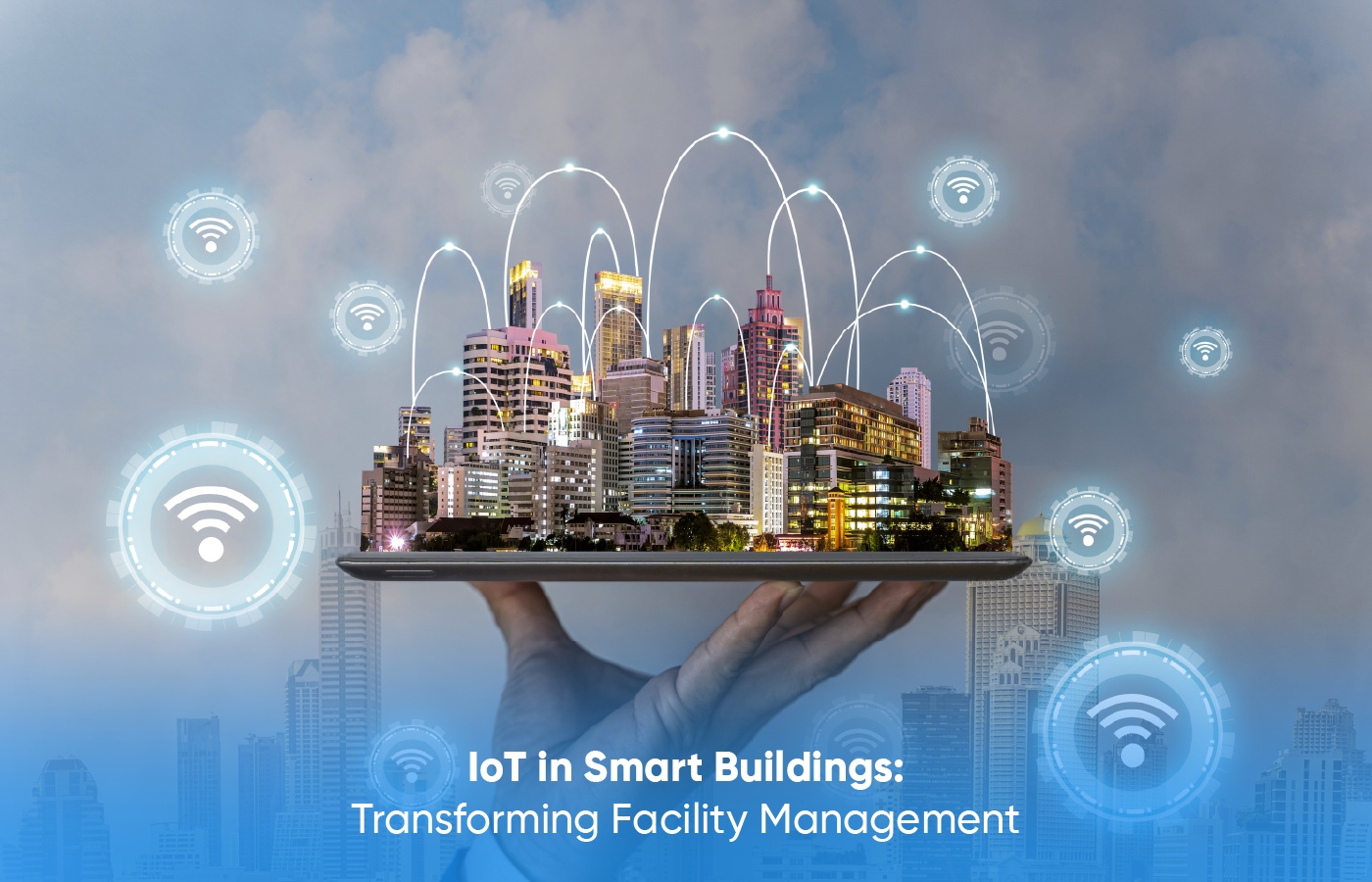In the rush of office hours and endless tasks, the primary office light is often overlooked in the greater scheme of workplace efficiency. Office lighting can boost employee well-being and productivity without being noticed…..
IoT in Smart Buildings: Transforming Facility Management

Introduction
Imagine walking into an office where the lights adjust to your presence, the temperature aligns with your preferences, and every inch of the space is optimized for efficiency. It sounds like a scene from a sci-fi movie, but this is the new normal thanks to IoT in smart buildings. For facility managers, IoT in smart buildings isn’t just a trend—it’s a powerful tool transforming the way buildings operate.
What Exactly Makes a Building Smart?
Picture this: You’re managing a corporate office with hundreds of employees. People are constantly adjusting the thermostat, lights are left on in empty rooms, and you’re always reacting to maintenance issues after the fact. Now imagine that same building but with technology doing all the heavy lifting. Lights switch off automatically when rooms are vacant, and sensors track temperature and occupancy to create the perfect environment. That’s the beauty of a smart building an ecosystem where every system, from HVAC to security, works together harmoniously, driven by IoT.
The Magic of IoT in Smart Buildings
Integrating IoT into smart buildings isn’t just about gadgets and data—it’s about creating a living, breathing environment that adapts to its occupants. Think of it as the difference between manually setting your home’s heating schedule versus owning a thermostat that knows when you’re home and adjusts itself. IoT works the same way on a larger scale, with sensors gathering real-time information and adjusting the building’s systems accordingly.
Real-Life Use Cases of IoT in Smart Buildings
1. Energy Management: The ‘Smart’ Cost Saver
In a skyscraper downtown, IoT sensors monitor every kilowatt of electricity used. It’s 5 PM, and as employees start leaving, the lights dim automatically, and the cooling systems scale back. By 7 PM, only critical areas remain lit and air-conditioned. The building breathes as the day winds down, saving energy without a second thought. The facility manager gets a notification: energy consumption has been reduced by 15% this week alone—no manual input required.
2. Space & Occupancy: Making Every Square Foot Count
In a buzzing corporate HQ, IoT sensors track occupancy levels in every room. Meeting spaces that used to sit empty are now booked based on actual usage data, allowing the company to redesign underutilized areas into creative hubs. The office isn’t just a place to work anymore—it’s a flexible, data-driven space that adapts to how employees work best.
3. Security: It’s Watching, Even When You’re Not
Late one night, a motion sensor near the front entrance picks up unusual movement. Cameras zoom in, lights come on, and an alert is sent to the security team—all without anyone being there. Thanks to IoT, the building acts like its own security guard, with cameras, sensors, and alarms seamlessly working together to ensure safety, even when everyone’s at home.
4. Maintenance: Predicting Problems Before They Happen
Maintenance teams used to spend hours manually inspecting equipment, looking for problems. Now, IoT in smart buildings systems monitor every machine, every HVAC unit, and every lightbulb. When a piece of equipment is nearing failure, the system sends a maintenance request before anything breaks down. No more surprise breakdowns, no more scrambling to fix something during peak hours—just smooth, efficient operations.
5. Sustainability: Leading the Charge
Think about a building that actively participates in sustainability. IoT systems monitor environmental conditions in real-time, adjusting energy use and water consumption to match the building’s actual needs. Waste is minimized, energy efficiency maximized, and the building becomes a living example of how technology can drive sustainability.
Steps to Start Your Smart Building Journey
Transitioning to a smart building isn’t about flipping a switch, it’s a thoughtful process, like upgrading from an old flip phone to the latest smartphone. You start by understanding the building’s specific needs, then selecting the right IoT devices that fit those needs. The next step? Integration, getting all your new tech talking to each other via a centralized system. Once that’s set, you test it thoroughly to ensure everything works together like clockwork. Finally, training your staff is the last piece of the puzzle, after all, even the smartest tech needs a human touch to get the best out of it.
Key Technologies Driving Smart Buildings
Smart buildings aren’t just about sensors and apps. They’re powered by an ecosystem of technologies:
Sensors:
These are the eyes and ears of your building. They gather data on everything from occupancy to temperature, feeding the system with real-time information.
Connectivity:
Without a strong network, your IoT in smart buildings are like a car without fuel. Reliable connectivity ensures every piece of tech communicates flawlessly.

Data Analytics:
All that data? It needs to be processed, analyzed, and turned into actionable insights. That’s where analytics comes in, helping you make data-driven decisions in real-time.
Building Automation Systems (BAS):
The BAS is the conductor of your smart building orchestra. It ensures every system—lighting, HVAC, security—plays in harmony.
Artificial Intelligence:
AI gives your building a brain. It takes all the data collected and makes decisions, automating processes and constantly learning to improve efficiency.

The Future of IoT in Smart Buidings
Fast-forward a few years, and smart buildings will be the norm, not the exception. AI will be even more integral, turning buildings into proactive, self-sustaining ecosystems. Predictive analytics will catch problems before they arise, and security will be smarter and faster. IoT will also continue to make buildings healthier places to live and work, focusing on wellness, air quality, and creating environments that enhance comfort and productivity.
Conclusion: A Future Built on Smarter Spaces
With IoT in smart buildings are no longer a distant dream Fthey’re here, revolutionizing facility management. From boosting efficiency to cutting costs and enhancing sustainability, IoT is the key to unlocking the full potential of modern spaces. As we look ahead, the buildings we work and live in will only get smarter, creating environments that are not just spaces but experiences.
Reach out to us at info@aastroelectronics.com to learn all about IoT in Smart Buildings. Follow Aastro Tech Electronics on Linkedin, Facebook, and Instagram to stay updated.
